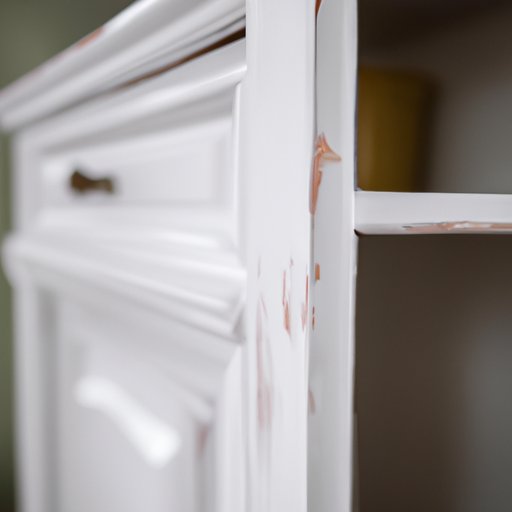Introduction
Painting wooden cabinets is a great way to update the look of your home. Whether you’re looking to give your kitchen cabinets an upgrade or you want to refresh a piece of furniture, there are some important steps to follow to ensure that the job is done properly. This article will provide a step-by-step guide on how to paint wooden cabinets, from prepping the surface and choosing the right paint and primer to avoiding common mistakes and adding finishing touches.
Preparing the Surface: Step-by-Step Guide to Painting Wooden Cabinets
The first step in painting wooden cabinets is to prepare the surface. This includes removing the old finish, sanding and prepping the wood, and cleaning the cabinet. Here’s a step-by-step guide to help you get started:
Remove Old Finish
If your cabinets have an existing finish, such as stain or paint, you’ll need to remove it before you start painting. You can do this by using a chemical stripper or sandpaper. Be sure to wear protective gear, such as goggles and gloves, when working with chemicals or sanding.
Sanding and Prepping the Wood
Once you’ve removed the old finish, you’ll need to sand the wood to create a smooth surface. Start with a coarse grit sandpaper and work your way up to a finer grit. If you have any deep scratches or gouges, you may need to use a wood filler to fill them in before sanding.
Cleaning the Cabinet
Once the wood is sanded, you’ll need to clean it to remove any dust or dirt. Use a damp cloth or vacuum to remove any debris. Once the surface is clean, let it dry completely before moving on to the next step.

Choosing the Right Paint and Primer for Wooden Cabinets
Once the surface is prepared, you’ll need to choose the right type of paint and primer for your cabinets. There are a few different types of paint that you can use, including latex, oil-based, and spray paint. You’ll also need to choose a primer that is compatible with the type of paint you’ve chosen. Some primers are designed specifically for wood, while others are better suited for metal or other surfaces.

Applying the First Coat of Paint: Tips and Techniques for a Professional Finish
When applying the first coat of paint, there are a few tools and techniques that you should consider for a professional finish. These include using a brush or roller for larger areas, using a spray gun for smaller areas, and using a brush for detail work. Make sure to use even strokes and start at the top and work your way down. Let the paint dry completely between coats.

Finishing Touches: Adding Details to Wooden Cabinets with Paint
Once the first coat of paint has been applied, you can add some finishing touches to make your cabinets stand out. Glazing and antiquing are two popular options that can give your cabinets a unique look. Glazing involves applying a thin layer of paint over the existing paint, while antiquing involves using a darker color to create a distressed look. Other painting techniques, such as sponging and stenciling, can also be used to add texture and interest to your cabinets.
How to Avoid Common Mistakes When Painting Wooden Cabinets
Painting wooden cabinets can be a rewarding experience, but there are some common mistakes that you should try to avoid. Poor preparation of the surface is one of the most common mistakes, as it can lead to uneven coverage and peeling paint. Make sure to remove any old finish, sand the wood, and clean it thoroughly before applying the paint. Another mistake is using the wrong type of paint or primer, which can result in bubbling or cracking of the paint. Finally, be sure to take your time and apply multiple coats of paint for a professional finish.
DIY or Hire a Pro? Pros and Cons of Painting Wooden Cabinets Yourself
Whether you choose to do it yourself or hire a pro, there are pros and cons to each option. Doing it yourself can be more cost-effective, and you’ll have the satisfaction of knowing that you did it yourself. However, it can also be time-consuming and require more patience. If you don’t have the time or inclination to do it yourself, hiring a pro can be a good option. They will usually have the necessary tools and expertise to get the job done quickly and professionally.
Conclusion
Painting wooden cabinets can be a fun and rewarding project. By following the steps outlined in this article, you can achieve a professional finish for your cabinets. Preparing the surface, choosing the right paint and primer, and avoiding common mistakes are all important steps to ensure a successful outcome. Whether you choose to do it yourself or hire a pro, you can get the look you want for your cabinets.
In conclusion, painting wooden cabinets is a great way to update the look of your home. With the right tools and techniques, you can achieve a professional finish. Be sure to prepare the surface, choose the right paint and primer, and avoid common mistakes for best results. Whether you choose to do it yourself or hire a pro, you can get the look you want for your cabinets.


